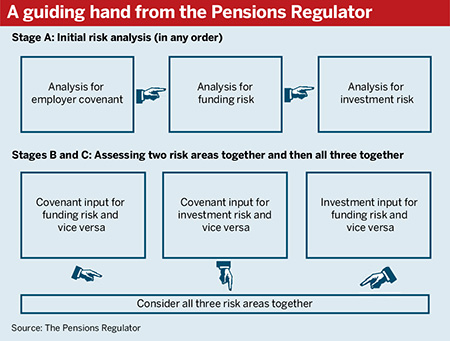The Pensions Regulator has issued a practical guide on integrated risk management to help trustees assess and respond to covenant, investment and funding risks, but experts have said schemes will need additional help.
The Pension Protection Fund and the regulator’s 10th annual Purple Book, published last week, which tracks trends across defined benefit schemes, showed the average section 179 funding level had fallen to 84 per cent at the end of March 2015, down from 97 per cent a year earlier.
What we’re trying to do here is eradicate surprises – both for the trustee and employer
Andrew Warwick-Thompson, The Pensions Regulator
The UK pensions watchdog endorsed an integrated approach to managing scheme risks in its May annual funding statement, which followed its revised code of practice for defined benefit scheme funding.
The regulator has gone one step further with its new guide, providing trustees with practical help on how to build a “proportionate and integrated approach to risk management” in conjunction with the scheme’s sponsoring employer.
The guidance outlines five steps on how to effectively manage risk on an ongoing basis:
Step 1: Initial considerations for putting an IRM framework in place;
Step 2: Risk identification and the initial risk assessment;
Step 3: Risk management and contingency planning;
Step 4: Documenting the decisions;
Step 5: Risk monitoring.
Mutual understanding
Andrew Warwick-Thompson, executive director for regulatory policy at the regulator, said IRM can improve mutual understanding between trustees and sponsoring employers, and improve historically “adversarial” relationships.

“What we’re trying to do here is eradicate surprises – [both] for the trustee and employer [and] get them to recognise they have a shared risk and they need to have a shared strategy for managing that risk,” he said.
Improving visibility of schemes’ financial positions will also protect the sponsors’ investors from “unpleasant surprises” arising from risks inherent within the scheme, in turn supporting sponsors’ sustainable growth over the long-term.
“Employers who engage in this kind of IRM approach with their trustees will be able to have more informed conversations with their analysts and indeed their shareholders,” he said.
Tyron Potts, associate and head of pensions research at consultancy Barnett Waddingham, said trustees may have sidelined a focus on covenant risk in favour of investment and funding decisions.
“The guidance is going to help trustees form a bigger picture of how risks sit within their scheme and how they fit together,” he said.
Potts said sponsors tend to be very involved where schemes pose material risks relative to the size of the underlying employer.
He added: “You tend to find that the employer wants to get involved, whereas [with] a smaller scheme perhaps the trustees need to push a bit more to get information out of the employer and get them more involved in the monitoring process."
Supporting an integrated approach
Demonstrating an integrated and risk-based approach to funding was deemed to be the biggest challenge for trustees over the coming year, according to consultancy Hymans Robertson's ‘Trustee Barometer’ published last month.
Nearly a quarter (22 per cent) of respondents to the survey ranked IRM as their number-one concern.
Calum Cooper, partner and head of trustee consulting at Hymans Robertson, said trustees will need help turning the guidance into something practical.
Nominating a "risk champion" may help trustees work towards a fully integrated approach. This could be a trustee with suitable experience and skills, a professional trustee or strategic risk consultant.
“[The] approach will look different for each scheme but trustees will need help,” said Cooper.














